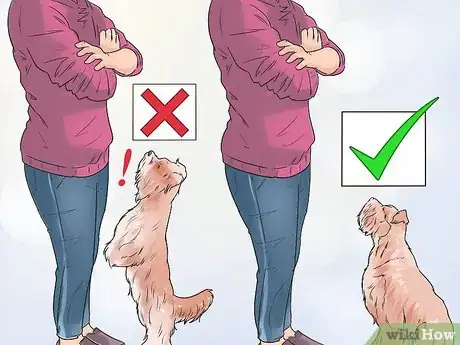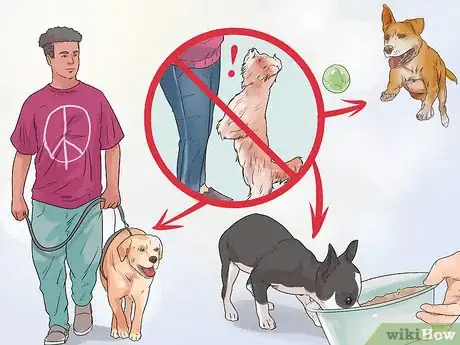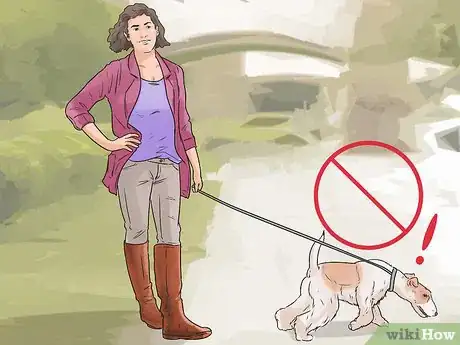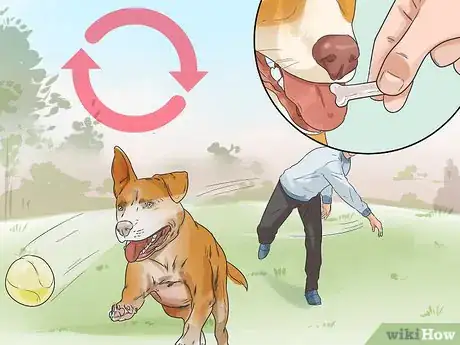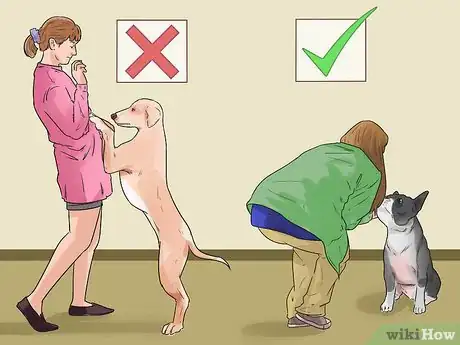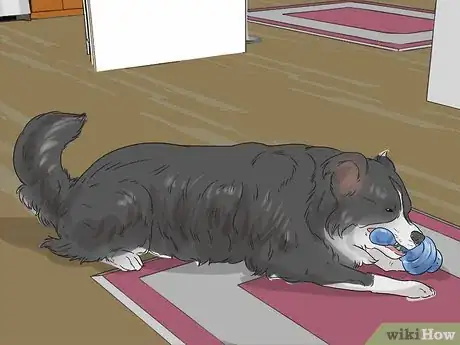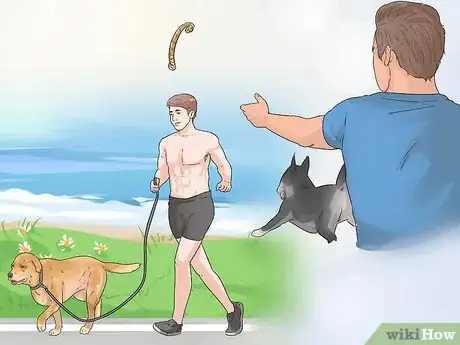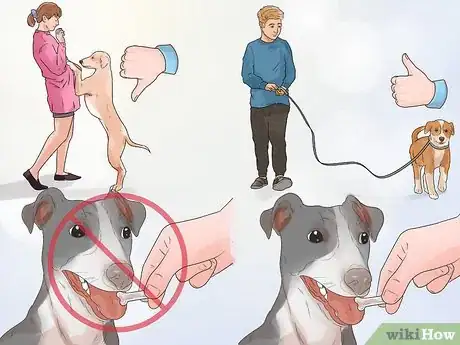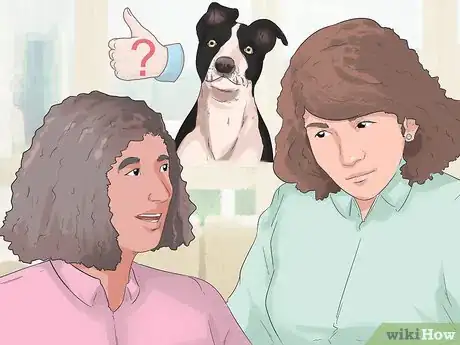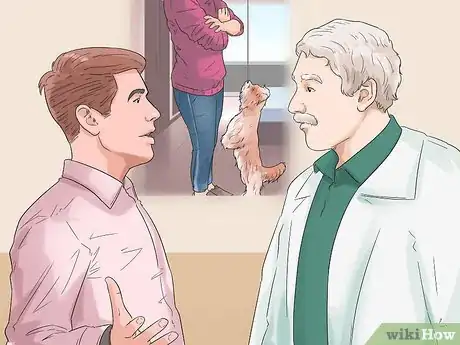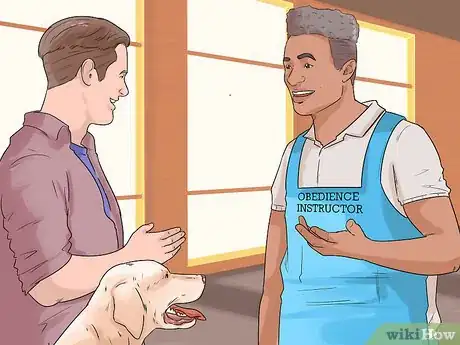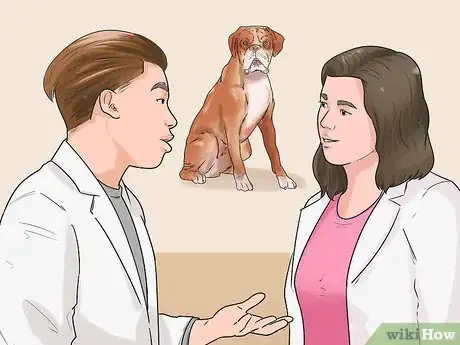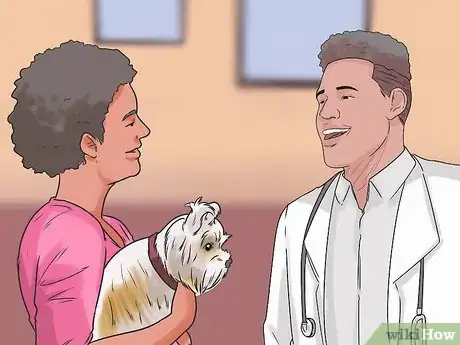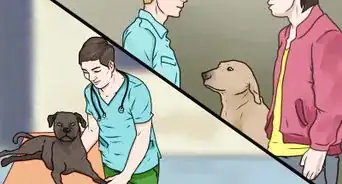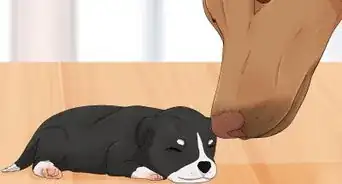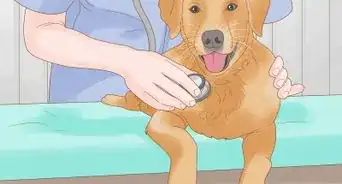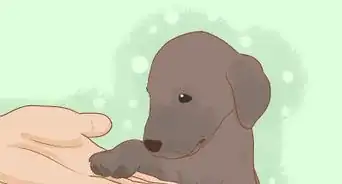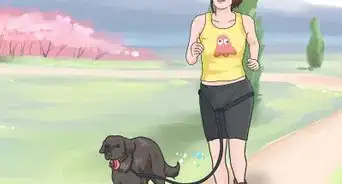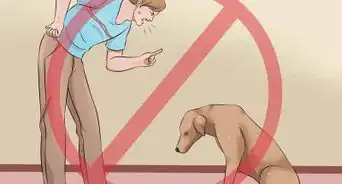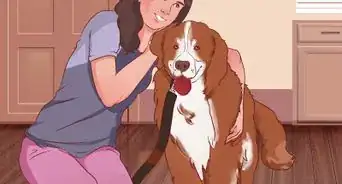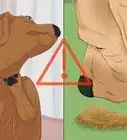This article was co-authored by Ryan Corrigan, LVT, VTS-EVN. Ryan Corrigan is a Licensed Veterinary Technician in California. She received her Bachelor of Science in Veterinary Technology from Purdue University in 2010. She is also a Member of the Academy of Equine Veterinary Nursing Technicians since 2011.
There are 7 references cited in this article, which can be found at the bottom of the page.
This article has been viewed 52,291 times.
Dogs will be dogs. Unfortunately, typical dog behavior doesn’t always line up well with human expectations. When that happens, it’s important to remember that while your dog’s behaviors may bother you, they are not always “bad” behaviors. Most of these dog habits are instinctual, but with some time and attention, you can help your dog develop different habits and behave in a manner that is more compatible with your expectations. Focus your attention on helping your dog transition from current behaviors to desired habits by rewarding positive changes. You should always start by taking your dog to visit the vet. This ensures your pet's behaviors aren't indications of health concerns.
Steps
Removing Rewards for Annoying Behavior
-
1Withhold attention until your dog stops annoying behaviors. It may be difficult, but in many situations, turning a blind eye to your dog’s annoying behaviors may be the key to solving the problem. Of course, if your dog’s annoying behavior is destructive, letting them continue to chew or rip up items is a reward. However, if your dog’s behavior is something like barking, nudging you, dropping a ball in your lap repeatedly, or jumping up on people at the door, the best immediate option may be to ignore the dog’s behavior.[1]
- For example, if a dog jumps up to greet you, do not pet the dog until it puts both feet on the floor.
- If a dog barks to get you to feed them, don’t feed them until after they stop barking.
- If your dog drops their ball in your lap repeatedly until you throw it, put the ball away until your dog is calm.
-
2Avoid “giving in” to pushy dogs. When your dog is persistent in trying to get you to take them for a walk, throw a ball, or feed them dinner at a specific time, don’t do what they want until they stop the behavior. Pushy dogs are the way they are because they’re used to getting their way. The only way to stop that behavior is by not giving in. The moment you do what they expect, you reinforce their belief that their pushy behaviors will work.[2]Advertisement
-
3Stop activities if your dog misbehaves. Whether you’re walking to the park with your dog pulling your shoulder out of socket or playing tug of war with a pup that nips your hand, the best response is to stop. In cases like these, the dog will see continued walking or playing as an indication that the behavior is acceptable. If the dog is behaving in an unacceptable way, stop the fun.
- Leash pulling is one of the most common annoying habits. People are often surprised to find out that not walking is the easiest way to fix the problem. As soon as your dog starts pulling, stop. Once the dog calms down and returns to your side, start walking again. It is also a good idea to teach your dog the “Heel” command. If you have difficulty training your dog, then seek out a trainer to help you. You can also use a Halti, Gentle Leader, or harness to help reduce your dog’s ability to pull on the leash.
- Biting, nipping, and mouthing are also behaviors many dog owners struggle with. This typically starts when dogs are puppies and it’s important to start discouraging this at a young age. As soon as the dog bites or nips, let out a high pitched yelp and go limp. This tells the dog they’ve done something that has hurt you, and they will stop.[3] You should also stop playing with your dog if he bites or nips you, or he may think that biting or nipping are acceptable behaviors during playtime.
-
4Be consistent with your dog’s training. The first time you or someone else rewards your dog’s unacceptable behavior again, all of your hard work will go out that window. Rewards aren’t just things like treats. A reward can be as simple as petting the dog when it jumps up to greet them or throwing the ball that your dog keeps repeatedly dropping it in their lap. Make sure that you are consistent, and work with friends and family to be consistent as well.[4] Everyone in your household should know what to do if your dog misbehaves to ensure that there is consistency in your dog’s training. Make sure everyone knows how to correct bad behaviors and how to reward good behaviors.
Establishing Better Behaviors
-
1Replace their undesirable behavior. While getting your dog to stop an annoying habit may be your goal, it’s important to remember your dog has a goal too. They aren’t barking, pushing, bringing you a toy, or engaging in other annoying behaviors for no reason. Figure out what your dog is trying to tell you, and teach them a new and better way to communicate.
- A great example is dogs who jump up to greet new guests. Instead of petting the dog and saying hi when it jumps up, ask your guests to wait to pet the dog when he sits down.
- If your dog barks to tell you it’s time for dinner, teach them to sit by their bowl, and don’t feed them until they do so. Use a simple command like “bowl.” Say, “bowl,” and if your dog goes to the dinner bowl, give them a treat, pet them, and tell them good job. Rehearse this regularly, and keep practicing until they know that sitting by their bowl is how they get fed.[5]
-
2Keep your dog busy. In many cases, annoying behavior is caused by boredom. Give your dog a puzzle toy, take them for a walk, or play a game with them. Dogs, like small children, need a lot of stimulation to avoid getting bored. The more activities you can give your dog to do on a daily basis, the better. Try giving your dog a job.
- Give your dog things to carry. Are you weeding the garden? Give your dog a handful of weeds to carry off. Are you bringing in groceries? Give your dog a small bag to bring in (even if it’s an empty one).
- Do something with your dog to help them expend excess energy before you have company, such as going for a walk or run, playing a game of fetch, or visiting the dog park. You can even engage your dog in activities while guests are over, such as by inviting friends and family to play with your dog in the backyard.
- Make your own puzzle toys. Use old socks and fill the toes with treats. Your dog will have to work to get them out, and this will keep them occupied.
- Buy toys that take time for your dog to chew through or that are designed to hide treats that your dog will work to get out.[6]
-
3Wear your dog out. A tired dog is a happy dog. Take them on a long walk. Play fetch. Go on play dates. Visit the local dog park. Do whatever you can to tire your dog out. If you burn off your dog’s excess energy, it will be less likely to engage in high energy and annoying behaviors.
- Your dog will need multiple play sessions daily to get enough exercise. Aim to exercise your dog in the morning and in the evening, such as before you go to work and after you get home.
- Additionally, interacting with your dog more is all dogs expect from many of the most annoying behaviors.
- These activities are also great training opportunities. If you want to teach your dog to sit when the doorbell rings, practice the "sit" command in the home or park or other areas, so it becomes natural for your pet. Reward learned behaviors during training.
- Best of all, you'll be spending more time with your pet!
-
4Reward preferred behaviors. This is essential to training your dog. It’s not enough simply to ignore or stop rewarding the annoying behaviors. You have to teach your dog to get what they need from you in a better way. Then, reward them over and over for this preferred behavior.
- If you want your dog to stop jumping up on visitors, ask your visitors not to pet them until they sit. Then, give them lots of attention and maybe even treats.
- If your dog is pulling on its leash, stop walking, but when your dog is following your directions to stay by you, reward that behavior by picking up the pace a little.
- Treats are a great way to reinforce your dog’s preferred behaviors, especially during the training process. Giving the dog the thing his annoying behavior was asking for may be plenty of reward.[7]
Getting Help From Others
-
1Ask friends and family for help. Building a new habit that your dog will only do when you’re around is not actually going to change the dog’s behavior. Whatever the behavior is, do what you can to make sure the dog will behave consistently with other people by recruiting your friends and family to help.[8]
- For instance, if the concern you have is with a dog jumping on visitors, ask your partner to answer the door and a friend to stop by. Your dog should respond to your partner’s sit command, and your friend should not pet the dog until it does so.
- If you’re working with your dog to be more comfortable while riding in cars, bring a friend or family member along to help you entertain and distract the dog on your trip.
-
2Educate people who visit your home. You should be consistent, and having a new person come over who doesn’t know the rules can quickly undo your hard work training your pup. If you notice your dog engaging in one of the behaviors you’re trying to change and see the friend rewarding the dog with attention, intervene quickly to redirect the behavior, and let your friend know what you’re doing.[9]
- If jumping up to greet people is the behavior you're changing, say something like, "Sorry about that. Could you wait to pet him until he sits down? We're trying to train him not to jump up."
- If your friend wants to take the dog for a walk, let them know about pulling in advance. Say something like, "He's been pulling on his leash, so anytime he pulls, we stop. Can you make sure to do that on your walk?"
-
3Take your dog to an obedience course. If your dog’s behavior is severe, obsessive, or could cause harm to someone in your household, it may be time to recruit a professional. Dog trainers have years of experience working with animals to change even the most deeply ingrained behaviors. Before you take the time and money to put your dog through obedience training, make sure you are committed to continue reinforcing this training in the home.[10]
-
4Get a pet sitter. It’s important that your dog is not able to continue the annoying behavior when you’re not at home. If you need to leave your dog at home for long hours, hire a professional pet sitter or ask a friend to watch the dog for you to make sure they’re not engaging in the old behavior when you’re not there.[11]
- There are a number of online resources available to help you find a trustworthy pet sitter to care for you dog. Care.com has offered help finding babysitters and nannies for years, and now you can even use the site to find people to care for your pets.
- If you’ll only be out of the house for a few hours at a time, you may be able to keep your dog in a crate while you’re gone. However, if you’re going to be out of the house for more than four hours, you may need to bring in a sitter.
-
5Go to the vet. If your dog suddenly develops an annoying habit, it may be trying to tell you it’s not well. Dogs can’t speak to you, so their behavior is all they have to indicate what they need. Pay attention to this, and always take your dog to the vet to make sure their “annoying” habit isn’t actually a serious health concern.[12]
- While you're at the vet, ask for advice on how to improve your pet's behaviors.
- Vets are also a great resource if you're interested in finding a pet sitter, dog walker, or obedience course.
References
- ↑ http://3lostdogs.com/how-to-solve-practically-any-annoying-dog-behavior-problem/
- ↑ http://www.pawculture.com/tips-advice/dog-training/5-pushy-dog-behaviors-and-how-to-deal-with-them/
- ↑ http://3lostdogs.com/how-to-solve-practically-any-annoying-dog-behavior-problem/
- ↑ http://www.quickanddirtytips.com/pets/dog-behavior/how-to-stop-your-dog%E2%80%99s-annoying-behavior
- ↑ http://3lostdogs.com/how-to-solve-practically-any-annoying-dog-behavior-problem/
- ↑ http://www.aspca.org/pet-care/dog-care/common-dog-behavior-issues/separation-anxiety
- ↑ http://www.whole-dog-journal.com/issues/17_15/features/Dog-Humping-Behavior_21156-1.html
- ↑ http://3lostdogs.com/how-to-solve-practically-any-annoying-dog-behavior-problem/
- ↑ http://3lostdogs.com/how-to-solve-practically-any-annoying-dog-behavior-problem/
About This Article
If your dog behaves in an annoying way, do your best to ignore the behavior until it stops. For example, don’t pet your dog if it jumps up on you or feed it scraps if it begs. However, you may need to actively intervene if the behavior is destructive, such as if your dog is chewing on the couch cushions. You can also avoid rewarding annoying behaviors by stopping whatever activity you are doing when the behavior happens. For instance, if your dog pulls its leash while you’re walking, stop walking until it calms down and comes back to your side. As you’re training your dog, stay consistent. Don’t give in to pushy and annoying behaviors, but also consistently reward your dog for appropriate behaviors. Keep reading for more tips from our Veterinarian co-author, including how to replace annoying habits with more appropriate ones.
